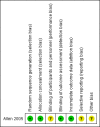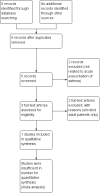Ketamine for management of acute exacerbations of asthma in children
- PMID: 23152273
- PMCID: PMC6483733
- DOI: 10.1002/14651858.CD009293.pub2
Ketamine for management of acute exacerbations of asthma in children
Abstract
Background: Asthma is the most common chronic disease in children, and children with asthma frequently visit the paediatric emergency departments with acute exacerbations. Some of these children fail to respond to standard therapy (aerosol beta(2)-agonist with or without aerosol anticholinergic and oral or parenteral corticosteroids) for acute asthma leading to prolonged emergency department stay, hospitalisation, morbidity (e.g. barotrauma, intubation) and death, albeit rarely. Ketamine may relieve bronchospasm and is a potentially promising therapy for children with acute asthma who fail to respond to standard treatment.
Objectives: To evaluate the efficacy of ketamine compared to placebo, no intervention or standard care for management of severe acute asthma in children who had not responded to standard therapy.
Search methods: We identified trials from the Cochrane Airways Group Specialised Register of trials (CAGR) and ClinicalTrials.gov. We reviewed reference lists of all primary studies and review articles for additional references. We contacted authors of identified trials and asked them to identify other published and unpublished studies. The latest search was in July 2012.
Selection criteria: Randomised controlled trials comparing ketamine to placebo or standard care in children (up to 18 years of age) presenting with an acute asthma exacerbation who had not responded to standard therapy.
Data collection and analysis: Two review authors independently selected studies. The data were extracted in pre-defined proforma and were analysed independently by two review authors. The data analysis was performed using Review Manager 5.1.
Main results: A single study enrolling 68 non-intubated children was found eligible for inclusion in review. The study had low or unclear risk of bias. It demonstrated no significant difference in respiratory rate, oxygen saturation, hospital admission rate (odds ratio (OR) 0.77; 95% confidence interval (CI) 0.23 to 2.58) and need for mechanical ventilation between ketamine (0.2 mg/kg intravenous bolus over one to two minutes, followed by a 0.5 mg/kg per hour continuous infusion for two hours) and placebo group. There were no significant side effects of ketamine in the study. There was also no difference in need for other adjuvant therapy (OR 2.19; 95% CI 0.19 to 25.40) and in Pulmonary Index Score (mean difference (MD) -0.40; 95% CI -1.21 to 0.41) between the groups.
Authors' conclusions: The single study on non-intubated children with severe acute asthma did not show significant benefit and does not support the case studies and observational reports showing benefits of ketamine in both non-ventilated and ventilated children. There were no significant side effects of ketamine. We could not find any trials on ventilated children. To prove that ketamine is an effective treatment for acute asthma in children, there is need for sufficiently powered randomised trials of high methodological quality with objective outcome measures of clinical importance. Future trials should also explore different doses of ketamine and its role in children needing ventilation because of severe acute asthma.
Conflict of interest statement
None known.
Figures
Comment in
-
Is ketamine effective for the management of acute asthma exacerbations in children?Ann Emerg Med. 2014 Mar;63(3):309-10. doi: 10.1016/j.annemergmed.2013.08.017. Epub 2013 Oct 23. Ann Emerg Med. 2014. PMID: 24268906 No abstract available.
References
References to studies included in this review
Allen 2005 {published data only}
-
- Allen JY, Macias CG. The efficacy of ketamine in pediatric emergency department patients who present with acute severe asthma. Annals of Emergency Medicine 2005;46(1):43‐50. - PubMed
References to studies excluded from this review
Hemmingsen 1994 {published data only}
-
- Hemmingsen C, Nielsen PK, Odorico J. Ketamine in the treatment of bronchospasm during mechanical ventilation. American Journal of Emergency Medicine 1994;12(4):417‐20. - PubMed
Howton 1996 {published data only}
-
- Howton JC, Rose J, Duffy S, Zoltanski T, Levitt MA. Randomized, double‐blind, placebo‐controlled trial of intravenous ketamine in acute asthma. Annals of Emergency Medicine 1996;27(2):170‐5. - PubMed
References to studies awaiting assessment
Tiwari 2016 {published data only}
-
- Tiwari A, Guglani V, Jat KR. Ketamine versus aminophylline for status asthmatic in children: A randomized, controlled trial [Abstract]. European respiratory journal 2014;44(Suppl 58):281.
Additional references
Akinbami 2006
-
- Akinbami LJ. The state of childhood asthma, United States, 1980–2005. Advance Data from Vital and Health Statistics. No. 381, 2006. www.cdc.gov/nchs/data/ad/ad381.pdf. (accessed 19 September 2012). - PubMed
Betts 1971
-
- Betts EK, Parkin CE. Use of ketamine in an asthmatic child: a case report. Anesthesia and Analgesia 1971;50(3):420‐1. - PubMed
Brenner 2009
-
- Brenner B, Corbridge T, Kazzi A. Intubation and mechanical ventilation of the asthmatic patient in respiratory failure. Proceedings of the American Thoracic Society 2009;6:371‐9. - PubMed
BTS 2009
-
- British Thoracic Society/Scottish Intercollegiate Guidelines Network. British guideline on management of asthma: a national clinical guideline 2009. www.sign.ac.uk/guidelines/fulltext/101/index.html. (accessed 19 September 2012).
Burburan 2007
-
- Burburan SM, Xisto DG, Rocco PRM. Anaesthetic management in asthma. Minerva Anestesiologica 2007;73(6):357‐65. - PubMed
CDC 1996
-
- Centers for Disease Control and Prevention (CDC). Asthma mortality and hospitalization among children and young adults ‐ United States, 1980‐1993. MMWR. Morbidity and Mortality Weekly Report 1996;45(17):350‐3. - PubMed
Cook 1991
-
- Cook DJ, Carton EG, Housmans PR. Mechanism of the positive inotropic effect of ketamine in isolated ferret ventricular papillary muscle. Anesthesiology 1991;74(5):880‐8. - PubMed
Corssen 1972
-
- Corssen G, Gutierrez J, Reves JG, Huber FC. Ketamine in the anesthetic management of asthmatic patients. Anesthesia and Analgesia 1972;51(4):588‐96. - PubMed
Crane 1989
-
- Crane J, Pearce N, Flatt A, Burgess C, Jackson R, Kwong T, et al. Prescribed fenoterol and death from asthma in New Zealand, 1981‐83: case‐control study. Lancet 1989;1(8644):917‐22. - PubMed
Denmark 2006
-
- Denmark TK, Crane HA, Brown L. Ketamine to avoid mechanical ventilation in severe pediatric asthma. Journal of Emergency Medicine 2006;30(2):163‐6. - PubMed
Ducharme 2008
-
- Ducharme FM, Chalut D, Plotnick L, Savdie C, Kudirka D, Zhang X, et al. The Pediatric Respiratory Assessment Measure: a valid clinical score for assessing acute asthma severity from toddlers to teenagers. Journal of Pediatrics 2008;152(4):476‐80. - PubMed
Fischer 1977
-
- Fischer MM. Ketamine hydrochloride in severe bronchospasm. Anaesthesia 1977;32(8):771‐2. - PubMed
Gateau 1989
-
- Gateau O, Bourgain JL, Gaudy JH, Benveniste J. Effects of ketamine on isolated human bronchial preparations. British Journal of Anaesthesia 1989;63(6):692‐5. - PubMed
Gergen 1988
-
- Gergen PJ, Mullally DI, Evans R. National survey of prevalence of asthma among children in the United States, 1976 to 1980. Pediatrics 1988;81(1):1‐7. - PubMed
GINA 2009
-
- Global Initiative for Asthma. Global strategy for asthma management and prevention, 2009. www.ginasthma.org/Guidelines/guidelines‐resources.html. (accessed 19 September 2012).
Gorelick 2004
-
- Gorelick MH, Stevens MW, Schultz TR, Scribano PV. Performance of a novel clinical score, the Pediatric Asthma Severity Score (PASS), in the evaluation of acute asthma. Academic Emergency Medicine 2004;11(1):10‐8. - PubMed
Green 1990
-
- Green SM, Johnson NE. Ketamine sedation for pediatric procedures: part 2, review and implications. Annals of Emergency Medicine 1990;19(9):1033‐46. - PubMed
Green 2000
-
- Green SM, Krauss B. The semantics of ketamine. Annals of Emergency Medicine 2000;36(5):480‐2. - PubMed
Higgins 2011
-
- Higgins JPT, Deeks JJ. Chapter 7: Selecting studies and collecting data. In: Higgins JPT, Green S (editors), Cochrane Handbook for Systematic Reviews of Interventions Version 5.1.0 [updated March 2011]. The Cochrane Collaboration, 2011. Available from www.cochrane‐handbook.org.
McCarty 2000
-
- McCarty EC, Mencio GA, Walker LA, Green NE. Ketamine sedation for the reduction of children's fractures in the emergency department. Journal of Bone and Joint Surgery. American Volume 2000;82‐A(7):912‐8. - PubMed
Nehama 1996
-
- Nehama J, Pass R, Bechtler‐Karsch A, Steinberg C, Notterman DA. Continuous ketamine infusion for the treatment of refractory asthma in a mechanically ventilated infant: case report and review of the pediatric literature. Pediatric Emergency Care 1996;12(4):294‐7. - PubMed
Ng 2002
-
- Ng KC, Ang SY. Sedation with ketamine for paediatric procedures in the emergency department ‐ a review of 500 cases. Singapore Medical Journal 2002;43(6):300‐4. - PubMed
NHLBI 2007
-
- National Heart, Lung, and Blood Institute. Expert panel report 3: guidelines for the diagnosis and management of asthma. 2007. www.nhlbi.nih.gov/guidelines/asthma/. (accessed 19 September 2012).
NICE 2007
-
- National Institute for Health and Clinical Excellence (NICE). NICE technology appraisal guidance 131. Inhaled corticosteroids for the treatment of chronic asthma in children under the age of 12 years. 2007. www.nice.org.uk/TA131. (accessed 19 September 2012).
Parker 1997
-
- Parker RI, Mahan RA, Giugliano D, Parker MM. Efficacy and safety of intravenous midazolam and ketamine as sedation for therapeutic and diagnostic procedures in children. Pediatrics 1997;99(3):427‐31. - PubMed
Petrillo 2001
-
- Petrillo TM, Fortenberry JD, Linzer JF, Simon HK. Emergency department use of ketamine in pediatric status asthmaticus. Journal of Asthma: Official Journal of the Association for the Care of Asthma 2001;38(8):657‐64. - PubMed
RevMan 2011 [Computer program]
-
- The Nordic Cochrane Centre, The Cochrane Collaboration. Review Manager (RevMan). Version 5.1. Copenhagen: The Nordic Cochrane Centre, The Cochrane Collaboration, 2011.
Roback 2005
-
- Roback MG, Wathen JE, Bajaj L, Bothner JP. Adverse events associated with procedural sedation and analgesia in a pediatric emergency department: a comparison of common parenteral drugs. Academic Emergency Medicine: Official Journal of the Society for Academic Emergency Medicine 2005;12(6):508‐13. - PubMed
Rock 1986
-
- Rock MJ, Reyes de la Rocha S, L'Hommedieu CS, Truemper E. Use of ketamine in asthmatic children to treat respiratory failure refractory to conventional therapy. Critical Care Medicine 1986;14(5):514‐6. - PubMed
Sarma 1992
-
- Sarma VJ. Use of ketamine in acute severe asthma. Acta Anaesthesiologica Scandinavica 1992;36(1):106‐7. - PubMed
Scarfone 2000
-
- Scarfone RJ, Loiselle JM, Joffe MD, Mull CC, Stiller S, Thompson K, et al. A randomized trial of magnesium in the emergency department treatment of children with asthma. Annals of Emergency Medicine 2000;36(6):572‐8. - PubMed
Sherwin 2000
-
- Sherwin TS, Green SM, Khan A, Chapman DS, Dannenberg B. Does adjunctive midazolam reduce recovery agitation after ketamine sedation for pediatric procedures? A randomized, double‐blind, placebo‐controlled trial. Annals of Emergency Medicine 2000;35(3):229‐38. - PubMed
Sly 1999
-
- Sly RM. Changing prevalence of allergic rhinitis and asthma. Annals of Allergy, Asthma & Immunology 1999;82(3):233‐52. - PubMed
So 2001
-
- So HY. Rapid sequence induction and intubation. Hong Kong Journal of Emergency Medicine 2001;8:111‐8.
Sobel 1999
-
- Sobel RM, Morgan BW, Murphy M. Ketamine in the ED: medical politics versus patient care. American Journal of Emergency Medicine 1999;17(7):722‐5. - PubMed
Spitzer 1992
-
- Spitzer WO, Suissa S, Ernst P, Horwitz RI, Habbick B, Cockcroft D, et al. The use of beta‐agonists and the risk of death and near death from asthma. New England Journal of Medicine 1992;326(8):501‐6. - PubMed
Strube 1986
-
- Strube PJ, Hallam PL. Ketamine by continuous infusion in status asthmaticus. Anaesthesia 1986;41(10):1017‐9. - PubMed
Werner 2001
-
- Werner HA. Status asthmaticus in children. Chest 2001;119(6):1913‐29. - PubMed
Youssef‐Ahmed 1996
-
- Youssef‐Ahmed MZ, Silver P, Nimkoff L, Sagy M. Continuous infusion of ketamine in mechanically ventilated children with refractory bronchospasm. Intensive Care Medicine 1996;22(9):972‐6. - PubMed
Publication types
MeSH terms
Substances
LinkOut - more resources
Full Text Sources
Other Literature Sources
Medical



